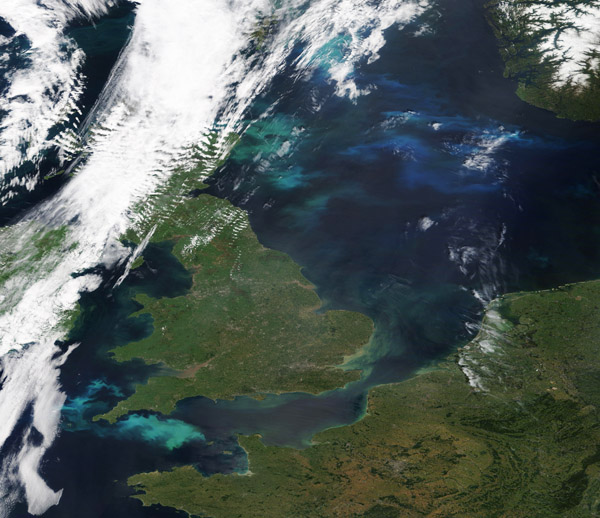Images
June 26, 2020 - Phytoplankton Blooms off Europe
Tweet
Stunning jewel-tones continued to paint whimsical colors in the waters of the North Sea, the English Channel, and the Celtic Sea in late June 2020. The Moderate Resolution Imaging Spectroradiometer (MODIS) on board NASA’s Terra satellite acquired a true-color image of the expansive, colorful blooms on June 24.
Phytoplankton are microscopic, plant-like organisms that live in these waters year-round in relatively small numbers. When conditions are right—correct water temperature, long daylight hours, and adequate nutrient load—they can reproduce explosively, creating these magnificent blooms that contain billions of organisms. While blooms may last for several months, individual organisms tend to live very short times. The size and color of a bloom depends on many factors, including the type of species that are present as well as ebb and flow of reproduction and death within the bloom.
These tiny, plant-like organisms turn sunlight and carbon dioxide into sugars and oxygen. In turn, they become food for the grazing zooplankton, shellfish, and finfish of the sea. Blooms fade as nutrient availability drops or they are consumed by booming numbers of zooplankton.
Image Facts
Satellite:
Terra
Date Acquired: 6/24/2020
Resolutions:
1km (599.5 KB), 500m (1.9 MB), 250m (5.2 MB)
Bands Used: 1,4,3
Image Credit:
MODIS Land Rapid Response Team, NASA GSFC
Tweet
Stunning jewel-tones continued to paint whimsical colors in the waters of the North Sea, the English Channel, and the Celtic Sea in late June 2020. The Moderate Resolution Imaging Spectroradiometer (MODIS) on board NASA’s Terra satellite acquired a true-color image of the expansive, colorful blooms on June 24.
Phytoplankton are microscopic, plant-like organisms that live in these waters year-round in relatively small numbers. When conditions are right—correct water temperature, long daylight hours, and adequate nutrient load—they can reproduce explosively, creating these magnificent blooms that contain billions of organisms. While blooms may last for several months, individual organisms tend to live very short times. The size and color of a bloom depends on many factors, including the type of species that are present as well as ebb and flow of reproduction and death within the bloom.
These tiny, plant-like organisms turn sunlight and carbon dioxide into sugars and oxygen. In turn, they become food for the grazing zooplankton, shellfish, and finfish of the sea. Blooms fade as nutrient availability drops or they are consumed by booming numbers of zooplankton.
Image Facts
Satellite:
Terra
Date Acquired: 6/24/2020
Resolutions:
1km (599.5 KB), 500m (1.9 MB), 250m (5.2 MB)
Bands Used: 1,4,3
Image Credit:
MODIS Land Rapid Response Team, NASA GSFC




